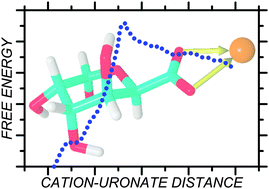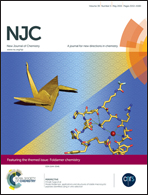Binding of bivalent metal cations by α-l-guluronate: insights from the DFT-MD simulations
Abstract
The negatively charged polyuronates exhibit a high affinity for binding the bivalent metal cations. This feature is used for the removal of heavy metals from aqueous solutions. The aim of the present paper is to: (i) present the computational strategy, helpful in simulating the metal ion–uronate complexes; (ii) illustrate its applicability to the example of the α-L-guluronate anion (the monomeric unit of alginates) interacting with bivalent metal ions: Zn2+, Cu2+, Cd2+, Mn2+ and Co2+. The study was carried out on the basis of the ‘hybrid’ molecular dynamics simulations in which the selected part of the system (uronate anions and metal cations) is treated with the ab initio level of accuracy, whereas the interactions within the rest of the system are approximated by the classical force fields. The results allowed for determining the basic structural and energetic (for example, the free energy profiles associated with the cation binding–unbinding process) characteristics related to the metal ion–guluronate complexes. Most of the studied ions exhibited the preference for monodentate binding. Bidentate binding can be observed for Mn2+ and Co2+ (dominant binding mode) and Cd2+ (secondary binding mode). The calculated binding free energy order (Cu > Co > Zn ∼ Mn > Cd) follows both the experimentally determined order of transition metal ion–alginate affinities and the metal–uronate interaction energies. The efficiency of the calculations and the general characteristics of the method allow for its potential use in simulations of other uronate–metal ion systems, increasing the range of methods which can be used for studying the metal biosorption processes.


 Please wait while we load your content...
Please wait while we load your content...